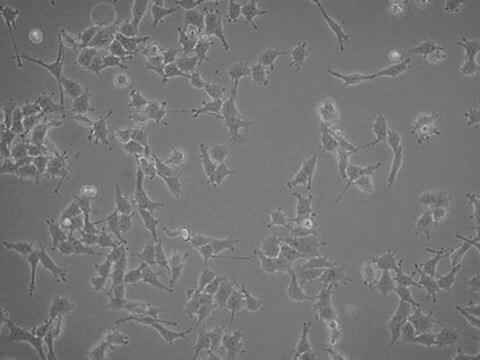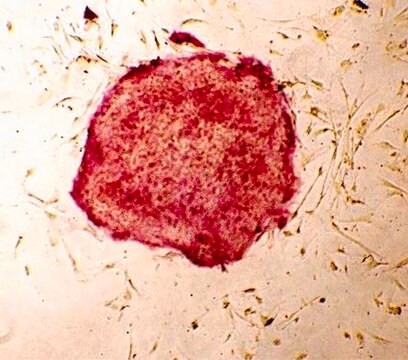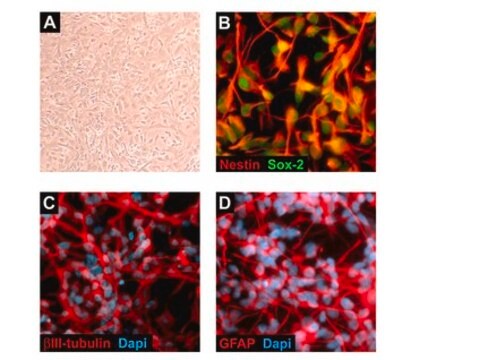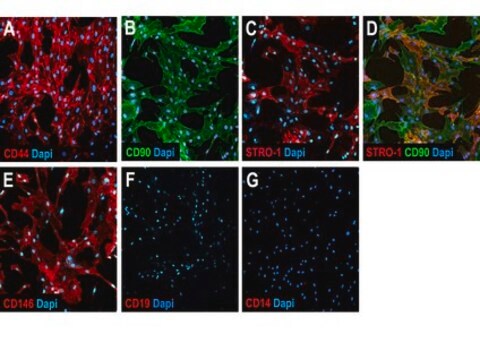SCR060
Human Neural Stem Cell Characterization Kit
The Human Neural Stem Cell Characterization Kit contains three molecular markers, Nestin, Sox 2 & Musashi that are frequently used to identify neural stem/progenitor cells.
Sign Into View Organizational & Contract Pricing
All Photos(4)
About This Item
UNSPSC Code:
12161503
eCl@ss:
32161000
NACRES:
NA.84
Recommended Products
Quality Level
species reactivity
human
manufacturer/tradename
Chemicon®
technique(s)
cell culture | stem cell: suitable
immunocytochemistry: suitable
input
sample type neural stem cell(s)
shipped in
dry ice
General description
The Human Neural Stem Cell Characterization Kit (Catalog Number SCR060) contains three molecular markers, Nestin (Lendahl, et al., 1990) and Sox 2 (Graham, et al., 2003) and Musashi (Sakakibara, et al., 1996) that are frequently used to identify neural stem/progenitor cells along with more differentiated lineage markers including bIII-tubulin for neurons, GFAP for astrocytes and O1 for oligodendrocytes. Mouse and rabbit immunoglobulins for the assessment of background staining are also included. All of the antibodies provided in the kit have been tested and optimized for use in immunocytochemistry on human neural stem cells. We recommend that the Human Neural Stem Cell Characterization Kit be used in conjunction with differentiation assays that demonstrate multipotentiality of the starting cell population.
Application
Research Category
Stem Cell Research
Stem Cell Research
The Human Neural Stem Cell Characterization Kit contains three molecular markers, Nestin, Sox 2 & Musashi that are frequently used to identify neural stem/progenitor cells.
Components
Mouse anti-Nestin, 50ug
Rabbit anti-Sox-2, 20ug
Rabbit anti-Musashi, 50ug
Mouse anti-bIII Tubulin, 50ul
Rabbit anti-GFAP, 50ul
Mouse anti-Oligodendrocyte marker O1, 20ug
Mouse IgM, 50ug
Mouse IgG, 100ug
Rabbit IgG, 100ug
Rabbit anti-Sox-2, 20ug
Rabbit anti-Musashi, 50ug
Mouse anti-bIII Tubulin, 50ul
Rabbit anti-GFAP, 50ul
Mouse anti-Oligodendrocyte marker O1, 20ug
Mouse IgM, 50ug
Mouse IgG, 100ug
Rabbit IgG, 100ug
Storage and Stability
When stored at the recommended storage conditions (refer to Kit Components), components are stable up to the expiration date. Do not expose to elevated temperatures. Discard any remaining reagents after the expiration date.
Legal Information
CHEMICON is a registered trademark of Merck KGaA, Darmstadt, Germany
Disclaimer
Unless otherwise stated in our catalog or other company documentation accompanying the product(s), our products are intended for research use only and are not to be used for any other purpose, which includes but is not limited to, unauthorized commercial uses, in vitro diagnostic uses, ex vivo or in vivo therapeutic uses or any type of consumption or application to humans or animals.
Storage Class
10 - Combustible liquids
Certificates of Analysis (COA)
Search for Certificates of Analysis (COA) by entering the products Lot/Batch Number. Lot and Batch Numbers can be found on a product’s label following the words ‘Lot’ or ‘Batch’.
Already Own This Product?
Find documentation for the products that you have recently purchased in the Document Library.
S Sakakibara et al.
Developmental biology, 176(2), 230-242 (1996-06-15)
There is increasing interest in the role of RNA-binding proteins during neural development. Drosophila Musashi is one of the neural RNA-binding proteins essential for neural development and required for asymmetric cell divisions in the Drosophila adult sensory organ development. Here
Jin-Seon Song et al.
Differentiation; research in biological diversity, 77(1), 29-37 (2009-03-14)
Regenerating human tooth ex vivo and biological repair of dental caries are hampered by non-viable odontogenic stem cells that can regenerate different tooth components. Odontoma is a developmental dental anomaly that may contain putative post-natal stem cells with the ability
Sakthidasan Jayaprakash et al.
Molecular and cellular biochemistry, 461(1-2), 171-182 (2019-08-21)
The BAF complex (SWI/SNF) is an ATP-dependent chromatin remodeler that adapts the structural organization of the chromatin. Despite a growing understanding of the composition of BAF in different cell types, the interaction network within the BAF complex is poorly understood.
U Lendahl et al.
Cell, 60(4), 585-595 (1990-02-23)
Multipotential CNS stem cells receive and implement instructions governing differentiation to diverse neuronal and glial fates. Exploration of the mechanisms generating the many cell types of the brain depends crucially on markers identifying the stem cell state. We describe a
Our team of scientists has experience in all areas of research including Life Science, Material Science, Chemical Synthesis, Chromatography, Analytical and many others.
Contact Technical Service








